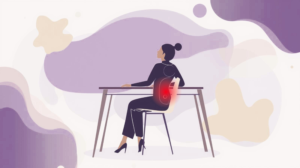Spending long hours at a desk can take a toll on your body, especially when your office chair cushion isn’t up to the task. But with so many options out there, how do you choose the right one? Should you go for a budget-friendly cushion, or is it better to invest in a high-quality one? In this article, we’ll compare cheap vs expensive office chair seat cushions based on comfort, durability, and value, helping you find the best option for your work setup, without breaking the bank.
Why Seat Cushions Matter for Office Chairs
Whether you work remotely or in a corporate setting, sitting for 6–8 hours (or more) daily can cause pressure on your spine, poor posture, and back pain. An office chair seat cushion is more than just an accessory, it can significantly enhance office chair comfort, provide tailbone relief, and support your lumbar region.
Cushions that align with ergonomic standards promote spinal alignment, reduce pressure points, and improve blood circulation. Investing in the right cushion can translate to better productivity, fewer sick days, and enhanced overall well-being.
Key Differences Between Cheap and Expensive Seat Cushions
When comparing budget and premium seat cushions, the real distinctions emerge in four main areas: materials, ergonomic design, durability, and ease of maintenance.
Materials Used
Memory Foam vs. Polyurethane Foam
Cheap seat cushions typically use basic polyurethane foam. While soft initially, they tend to flatten out quickly, offering little support over time. In contrast, memory foam seat cushions—often found in higher-end models- contour to your body shape, distributing weight evenly and relieving pressure from the tailbone and lower back.
Gel-Infused and Cooling Technologies
Expensive cushions frequently incorporate gel-infused foam or cooling layers to address heat retention, a common complaint during long hours of sitting. Cheap cushions rarely offer these technologies, which can lead to discomfort in warmer climates or seasons.
Design and Ergonomic Features
Contoured vs. Flat Cushions
Most affordable seat cushions are flat, providing minimal anatomical support. Premium models tend to feature contoured designs that cradle your hips, support spinal alignment, and reduce pressure points. This is especially useful for users seeking a lumbar support cushion or dealing with back pain.
Tailbone and Lumbar Support
A tailbone relief cushion, often with a U-shaped cutout, is more likely found in high-end products. This helps alleviate pressure on the coccyx and lower spine. Some expensive cushions also include built-in lumbar support, which is absent in lower-cost alternatives.
Durability and Lifespan
A major differentiator is how long the cushion lasts. Cheap models may show wear within months, losing shape and support. Premium seat cushions, often with high-density memory foam or reinforced stitching, can last for years, offering consistent performance over time.
Washability and Maintenance
Budget-friendly cushions may lack removable covers or be made with materials that are hard to clean. In contrast, expensive options usually come with removable, machine-washable covers and moisture-resistant inner linings, ensuring hygiene and easy upkeep.
Performance Comparison: Cheap vs. Expensive
Comfort Over Long Hours
When sitting for extended periods, comfort is critical. Affordable seat cushions may offer temporary relief but often fall short in long-term use due to insufficient support or padding. Premium cushions are engineered for comfort over long hours, with high-grade materials that retain their structure.
Impact on Posture and Back Health
Expensive seat cushions often promote better posture through ergonomic shaping. By supporting the natural curve of the spine, they help reduce fatigue and improve back health. Cheap cushions may lack the firmness or structure to correct posture effectively, potentially worsening existing discomfort.
Heat Retention and Breathability
Inexpensive cushions often trap heat, making you sweaty and uncomfortable. Higher-end options with breathable mesh covers or gel cooling layers offer a better sitting experience, especially in warmer environments.
Pros & Cons Table: Cheap vs Expensive Seat Cushions
| Feature | Cheap Cushion | Expensive Cushion |
| Price | Affordable | Higher upfront cost |
| Material | Polyurethane foam | High-density memory foam / gel |
| Comfort | Short-term | Long-term |
| Durability | 2–6 months | 2–5 years |
| Ergonomics | Minimal | Contoured, ergonomic |
| Tailbone Relief | Rarely | Yes, U-shape cutout |
| Heat Control | Poor | Cooling gel or mesh |
| Washability | Not always | Removable covers |
| Ideal For | Occasional users | Full-time desk users, back pain |
Types of Foam Used in Seat Cushions
- Polyurethane Foam — soft but flattens fast
- Memory Foam — contours to body, great for posture
- High-Density Foam — firmer, long-lasting
- Gel-Infused Foam — cooling, ideal for heat-sensitive users
- Hybrid Foam — combines gel + memory foam for optimal comfort
How to Choose the Right Seat Cushion for Your Body Type
1. For Tailbone Pain / Coccyx Issues
Choose a U-shaped tailbone pressure relief cushion with memory foam.
2. For Lower Back Pain
Pick an ergonomic office seat cushion with lumbar contouring.
3. For Heavy Body Weight
Go for high-density foam cushions that won’t sink under pressure.
4. For Sweating / Long Sitting Hours
Choose a cooling gel seat cushion or breathable mesh cover.
5. For Office + Car Use
Choose a portable, lightweight memory foam cushion.
Top Recommended Office Chair Seat Cushions (India)
Budget-Friendly Options
- betterhood Orthopedic Seat Cushion – ₹1,799 (great for posture + tailbone relief)
- Wakefit Orthopedic Seat Cushion – ₹1,299
- The White Willow Coccyx Cushion – ₹1,899
- AmazonBasics Gel Seat Cushion – ₹1,499
- Dr Trust Orthopedic Seat Cushion – ₹2,200
Premium Options
- Sunday Fit Pro Gel Cushion
- Feagar Ergonomic Memory Foam Cushion
- BackGood Orthopedic Seat Cushion
These are ideal if you’re looking for the best seat cushion office option in India.
Signs Your Current Cushion Is Hurting Your Posture
- You constantly shift or feel numbness
- Your tailbone or lower back hurts
- The cushion feels thin or flat
- You slouch without support
- You feel hip or pelvic pressure after sitting
If you notice these signs, it’s time to upgrade to a memory foam chair cushion or ergonomic option.
Cost Analysis: Is Expensive Always Better?
Short-Term vs. Long-Term Value
While a budget-friendly seat cushion might cost you less upfront, you may need to replace it multiple times within a year. An expensive cushion might seem costly initially but offers greater cost-effective seat comfort over time due to its durability and superior support.
Budget Constraints and Use Case
If you’re a light user—say, working only a few hours at a desk daily—a cheap cushion might suffice. However, for full-time professionals or those suffering from back pain, a premium cushion for back pain is often worth the investment.
When to Upgrade Your Cushion
If your current cushion has flattened, causes discomfort, or no longer supports your posture, it’s time to consider upgrading. Frequent shifting, backaches, or tailbone pain are signs that your cushion is underperforming, regardless of its original price tag.
Conclusion: Which One Should You Buy?
The choice between a cheap and expensive seat cushion comes down to usage, health needs, and budget. If you sit for prolonged hours, have posture issues, or experience discomfort, a premium ergonomic seat cushion offers better support, comfort, and long-term value. However, for occasional use or travel, a budget-friendly office cushion may be sufficient.
Investing in your seating comfort is investing in your health. While not all expensive options are automatically better, cheap cushions often compromise on key features. Evaluate your personal needs, compare materials and ergonomic benefits, and choose the option that aligns best with your daily routine and physical well-being.
Frequently Asked Questions
1. Do cheap cushions provide enough support for long hours?
Not always. Cheap cushions can lose their shape and firmness quickly, making them less supportive for extended sitting.
2. Can a cheap cushion help with back pain?
It may offer temporary relief, but for consistent back support and posture correction, a premium cushion is generally more effective.
3. Is memory foam better than gel in seat cushions?
Memory foam provides contouring support, while gel offers better cooling. Some high-end cushions combine both for optimal comfort.
4. When should I replace my office chair seat cushion?
Replace your cushion when it becomes flat, loses support, or causes discomfort. On average, this may be every 6–24 months, depending on usage and quality.























